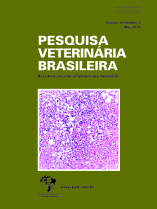 |
|
|
|
Year 2019 - Volume 39, Number 5
|

|
Staphylococcus aureus and Streptococcus agalactiae: prevalence, resistance to antimicrobials, and their relationship with the milk quality of dairy cattle herds in Minas Gerais state, Brazil, 39(5):308-316
|
ABSTRACT.- Mesquita A.A., Rocha C.M.B.M., Bruhn F.R.P., Custódio D.A.C., Braz M.S., Pinto S.M., Silva D.B. & Costa G.M. 2019. Staphylococcus aureus and Streptococcus agalactiae: prevalence, resistance to antimicrobials, and their relationship with the milk quality of dairy cattle herds in Minas Gerais state, Brazil. Pesquisa Veterinária Brasileira 39(5):308-316. Departamento de Medicina Veterinária, Universidade Federal de Lavras, Campus Universitário, Cx. Postal 3037, Lavras, MG 37200-000, Brazil. E-mail: marciocostavet@gmail.com
Bovine mastitis is the most frequent disease worldwide in dairy herds, causing high economic losses to producers and industry, as well as having implications for public health due to the zoonotic potential of some agents involved in its etiology and the increased risk of antimicrobial residues in milk and its derivatives. Considering the multifactorial aspect of this disease, knowledge of the agents involved in its etiology and their antimicrobial susceptibility profiles is very important. This study was conducted with 306 dairy herds from the Campo das Vertentes region, located in the south of Minas Gerais state, whose owners were milk suppliers to a dairy in the same region. The study involved approximately 34,000 dairy cows and covered an area of approximately 12,564 km2. In these herds, prevalence rates of Staphylococcus aureus and Streptococcus agalactiae and their relationship with bulk milk somatic cell counts (BMSCC), total bacterial counts (TBC), and daily production were evaluated. In addition, analyses of resistance of these pathogens to the antimicrobials most commonly used in the treatment of mastitis in dairy herds were performed. Microbiological analyses of milk samples from collect from bulk milk tanks were performed aiming to evaluate the prevalence of S. aureus and S. agalactiae. For these proposes, the modified Baird-Parker Agar medium was used for detection of S. aureus and the modified Edwards Agar medium, enriched with 5% defibrinated sheep blood, was used for detection of S. agalactiae. The disc diffusion technique was applied to evaluate antimicrobial resistance. Results show high prevalence rates of S. aureus (70.3%) and S. agalactiae (67.0%) in the dairy farms studied, with 47.71% of the herds showing both pathogens. Associations between BMSCC and the presence of pathogens S. aureus and S. agalactiae and between TBC and the presence of S. agalactiae were observed, demonstrating the influence of these pathogens in milk quality. No variation was observed in the distribution of S. aureus and S. agalactiae in the different strata of daily production. High levels of resistance and multi-resistance were observed among the pathogens S. aureus and S. agalactiae. The results indicate the need for more effective control measures for mastitis caused by S. aureus and S. agalactiae in the dairy herds of the region studied and more judicious use of antimicrobials in order to reduce the problem of resistance to them. |
| |
|
|
| |
|
 |